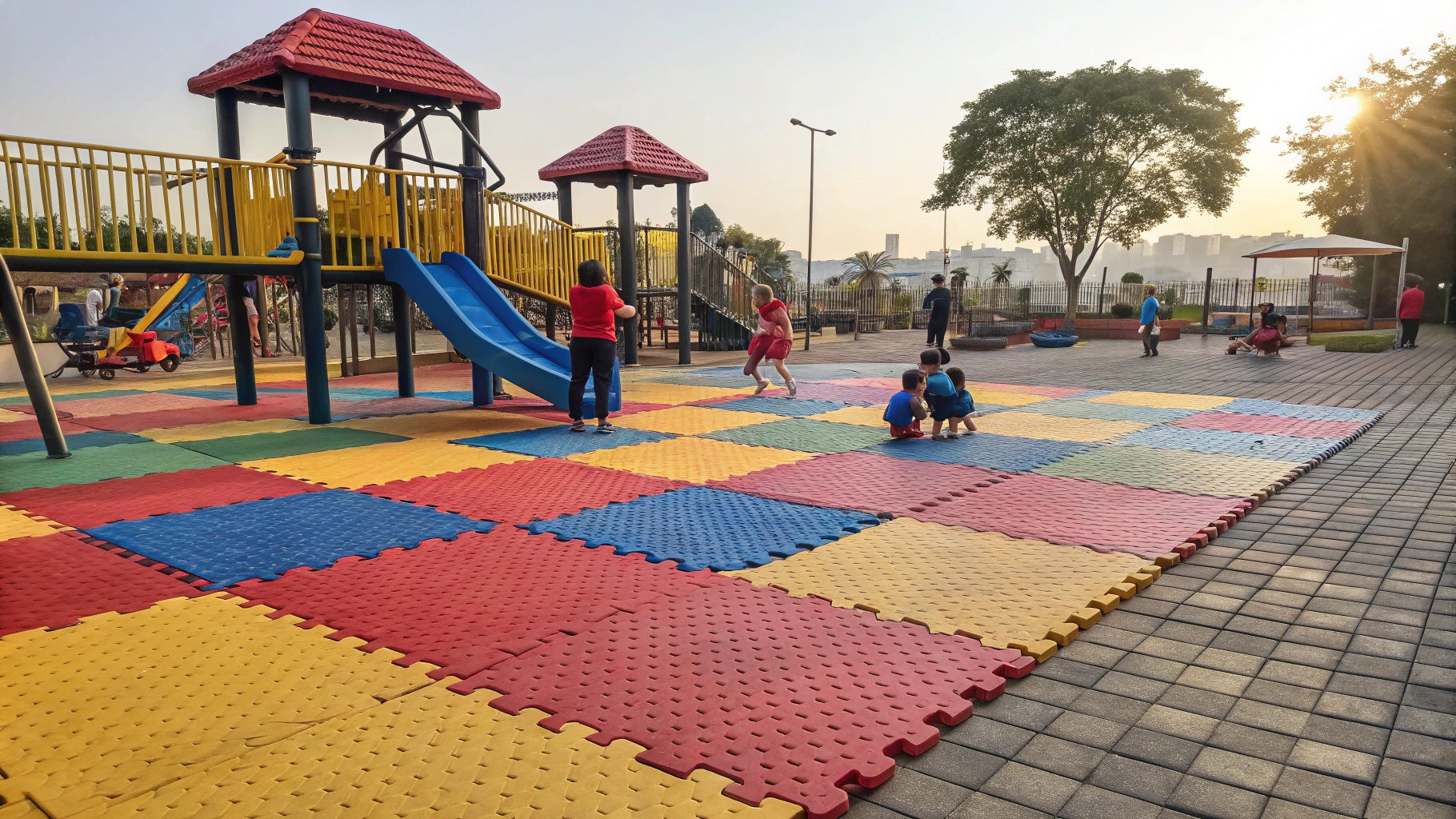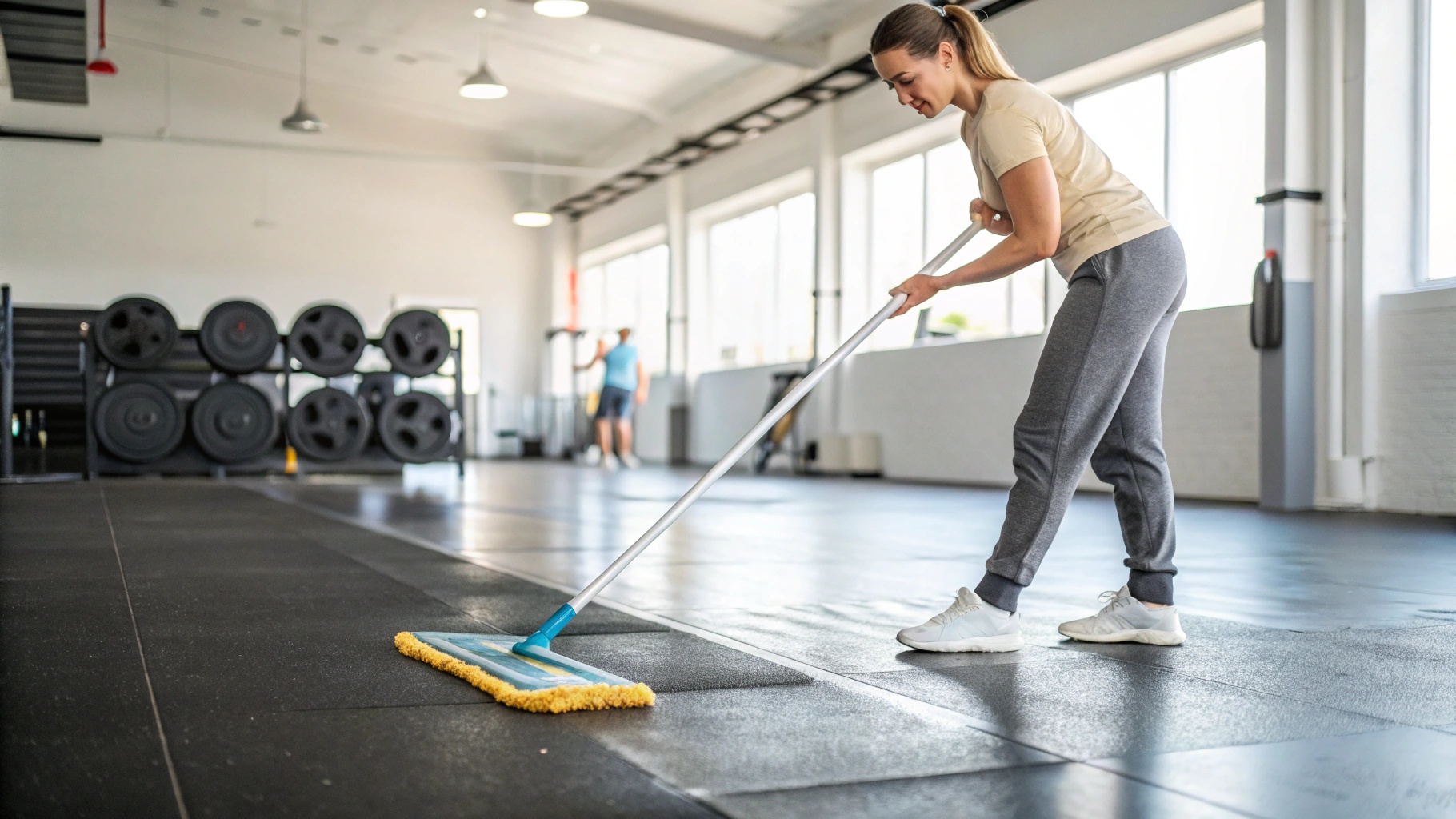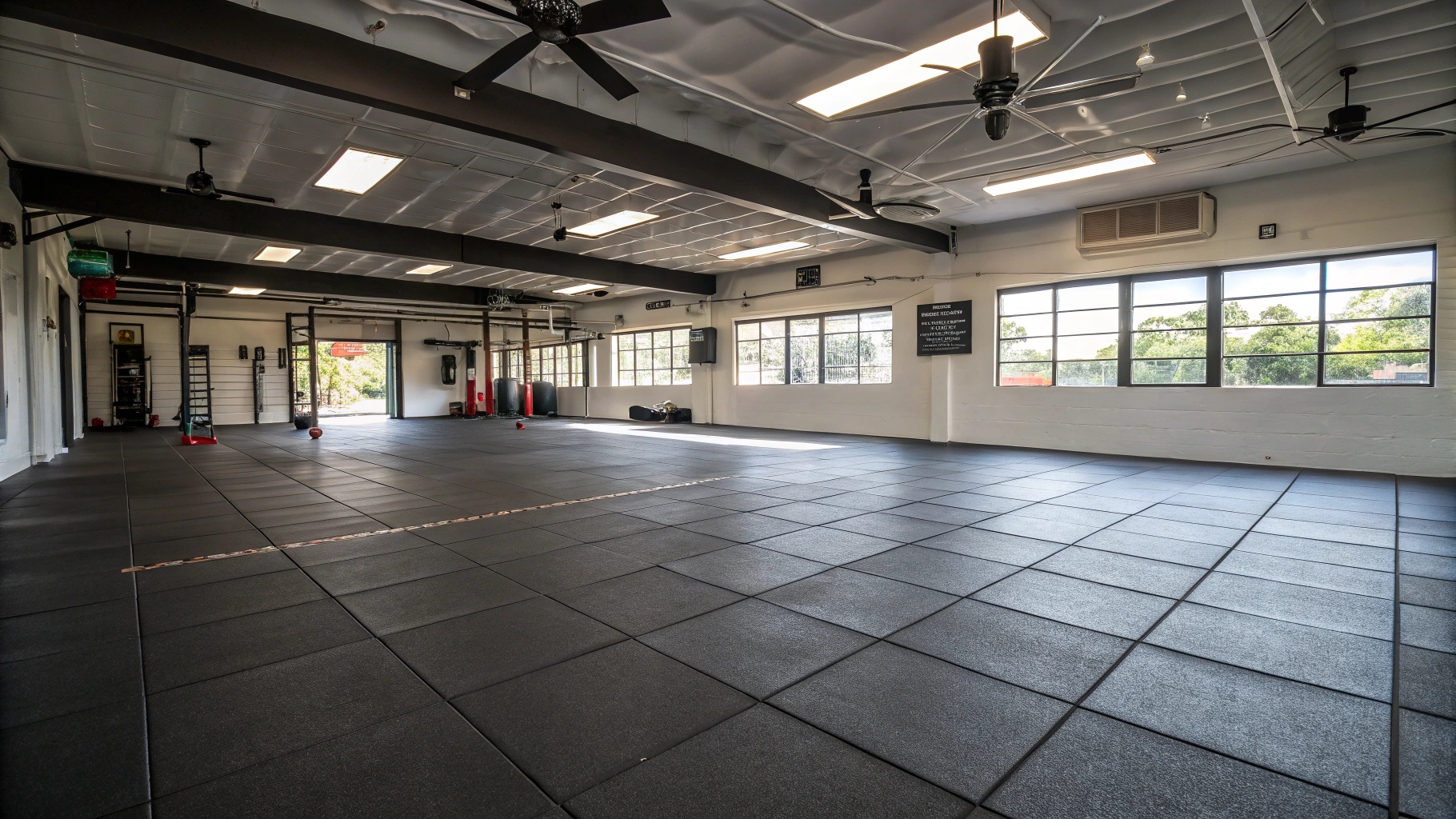Choosing the right flooring can feel like navigating a minefield. You want something durable, safe, and maybe even eco-friendly. But what about the downsides?
Rubber flooring, while popular for gyms and high-traffic areas, has some drawbacks. These can include potential toxicity, slipperiness when wet, odor, cost, maintenance, fading, and concerns about its environmental impact and other issue.
](https://www.byfitgear.com/wp-content/uploads/2025/03/Man-looking-at-rubber-floor-options-with-a-confused-expression.jpg) Confused man looking at rubber floor options
Confused man looking at rubber floor options
It’s easy to get lost in the technical jargon and marketing claims surrounding flooring options. Let’s cut through the noise and explore the real disadvantages of rubber flooring, so you can make a truly informed decision.
Is Rubber Flooring Toxic?
Worried about hidden dangers lurking in your flooring? You’re not alone. The question of toxicity is a big one, especially when it comes to materials like rubber.
The short answer is: it depends. Some rubber flooring1 can release harmful chemicals2, while others are safer. This primarily hinges on the manufacturing process3 and the materials used.
](https://www.byfitgear.com/wp-content/uploads/2025/03/Close-up-of-rubber-flooring-with-a-child-playing-on-it.jpg) Child playing on rubber flooring
Child playing on rubber flooring
Let’s delve a little deeper to help clarify this important issue and make the right choice.
What Chemicals Are Used in Rubber Flooring?
The composition of rubber flooring can be a bit of a chemical cocktail. The base is often synthetic rubber, like styrene-butadiene rubber (SBR), or recycled rubber from tires. These might be mixed with fillers, pigments, and, crucially, curing agents.
- Vulcanization4: This is the key process that gives rubber its durability and elasticity. It often involves sulfur and other chemicals like accelerators and activators.
- Fillers:These add bulk and can include things like carbon black or calcium carbonate
- Pigments:These give the rubber flooring its color.
Think of it like baking a cake. You have your base ingredients (rubber), but the "extras" (fillers, curing agents) determine the final product’s properties, including potential toxicity. BYFIT is dedicated to providing high-quality Gym Rubber Flooring product, striving to become a trusted partner for our different types of customers.
Does Rubber Flooring Off-Gas VOCs?
Volatile Organic Compounds (VOCs)5 are chemicals that can evaporate into the air, and some are harmful to health. The concern with rubber flooring is that incomplete vulcanization can cause problems. If the rubber isn’t fully "cured," it can release VOCs.
- Benzene Series: Low-grade rubber flooring might release benzene series compounds, up to 0.8mg/m³, due to this incomplete process.
- Antimony Trioxide: Fire-retardant flooring (B1 certified) might contain residual antimony trioxide6, a potential health hazard.
As my experience, I’ve seen firsthand how these seemingly small chemical residues can impact indoor air quality.
Is Rubber Flooring Safe for Children and Pets?
This is where the details really matter. The potential for VOC off-gassing and the presence of chemicals like antimony trioxide raise concerns.
| Concern | Impact | Mitigation |
|---|---|---|
| VOC Off-Gassing | Respiratory irritation, allergy risk | Choose low-VOC or no-VOC flooring |
| Chemical Residues | Increased allergy risk (potentially 37% for kids) | Look for certifications, check materials |
| Heavy Metals (Lead) | Found in some recycled rubber, neurotoxic | Request test reports, ensure compliance |
BYFIT reminds you: Always make sure your flooring material safety.
Is Rubber Flooring Slippery When Wet?
Imagine a busy gym, sweat flying, water bottles spilling… the last thing you want is a slippery floor. So, how does rubber flooring hold up in wet conditions?
Rubber flooring generally provides good traction, but it’s not entirely slip-proof. The level of slip resistance varies depending on the specific type of rubber and its texture.
](https://www.byfitgear.com/wp-content/uploads/2025/03/Person-slipping-on-a-wet-rubber-floor.jpg) Person slipping on wet rubber floor
Person slipping on wet rubber floor
Let us explore some of the specific data behind this.
What is the Slip Resistance Rating of Rubber Flooring?
Slip resistance is measured using a "coefficient of friction7" (COF). A higher COF means more grip.
- DIN511308: This German standard is commonly used. A wet friction coefficient of 0.6 is often cited for rubber flooring.
- Reality Check: Lab tests don’t always reflect real-world conditions. Sweat, spills, and even cleaning products can create a thin liquid film, reducing the effective slip resistance.
I once had a client who insisted on a specific rubber flooring based solely on its lab-tested COF. After a few near-accidents in his gym, he realized the importance of considering real-world factors.
How Can I Make Rubber Flooring Less Slippery?
The key is to disrupt that liquid film. Here’s how:
- Texture: Choose rubber flooring with a textured surface. 3D convex designs are particularly effective at breaking surface tension.
- Cleaning: Regular cleaning with appropriate products prevents buildup that can make the floor slick.
- Mats: Place absorbent mats in high-spill areas.
Are There Specific Types of Rubber Flooring That Are More Slip-Resistant?
Yes! Look for:
- Textured Surfaces: As mentioned, texture is key.
- EPDM Rubber9: This type often has good slip resistance.
- Specialized Coatings: Some manufacturers offer anti-slip coatings.
Does Rubber Flooring Smell?
That distinctive "new tire" smell is often associated with rubber flooring. But what causes it, and is it something to worry about?
Yes, rubber flooring can have a noticeable odor, especially when new. This smell is primarily due to the release of volatile organic compounds (VOCs) during and after the manufacturing process.
](https://www.byfitgear.com/wp-content/uploads/2025/03/Person-wrinkling-their-nose-near-new-rubber-flooring.jpg) Person wrinkling nose near rubber flooring
Person wrinkling nose near rubber flooring
What Causes the Rubber Smell in Flooring?
The primary culprit is the vulcanization process.
- Sulfur Compounds: These are released during curing and can have a strong, pungent odor.
- Residual Solvents: Some manufacturing processes use solvents that can linger and contribute to the smell.
How Long Does the Rubber Smell Last?
It varies. Factors include:
- Type of Rubber: Recycled rubber (like from tires) often has a stronger, longer-lasting smell.
- Ventilation: Good airflow helps dissipate the odor faster.
- Manufacturing Process: High-quality, properly cured rubber tends to have less odor.
In most cases, the smell will significantly fade within a few weeks to a few months.
How Can I Get Rid of the Rubber Smell?
Here are some tips:
- Ventilation: Open windows and use fans to circulate air.
- Cleaning: Wash the floor with a mild detergent and water.
- Air Purifiers: HEPA filters can help remove VOCs from the air.
- Time: Sometimes, patience is the best solution. The smell will naturally dissipate over time.
Is Rubber Flooring Expensive?
Let’s talk about the bottom line. How does rubber flooring stack up against other options in terms of cost?
Rubber flooring can range from relatively affordable to quite expensive, depending on the type, thickness, and quality. It’s generally more expensive than vinyl but can be comparable to or cheaper than some hardwood or tile options.
](https://www.byfitgear.com/wp-content/uploads/2025/03/Comparing-price-tags-of-different-flooring-types.jpg) Comparing price tags of flooring
Comparing price tags of flooring
What is the Average Cost of Rubber Flooring Per Square Foot?
Here’s a general idea (prices can vary widely):
- Rolled Rubber: $2 – $8 per square foot
- Interlocking Tiles: $3 – $12 per square foot
- Thick Mats: $10 – $30+ per square foot
How Does the Cost of Rubber Flooring Compare to Other Flooring Types?
| Flooring Type | Average Cost (per sq ft) | Notes |
|---|---|---|
| Rubber | $2 – $30+ | Wide range depending on type, thickness, quality |
| Vinyl | $1 – $5 | Generally cheaper, but less durable |
| Hardwood | $5 – $15+ | Can be more expensive, requires more maintenance |
| Tile (Ceramic/Porc) | $3 – $10+ | Comparable in price, but installation can be more costly |
| Laminate | $1 – $6 | Less durable. Water can cause significant swelling and/or staining, rendering the flooring uneven at the seams and unsightly. |
Are There Ways to Save Money on Rubber Flooring?
Absolutely! Consider these options:
- Thinner Flooring: If you don’t need heavy-duty thickness, opt for a thinner (and cheaper) option.
- Recycled Rubber: This can be more affordable than virgin rubber.
- DIY Installation: If you’re handy, installing interlocking tiles yourself can save on labor costs.
- Shop Around: Compare prices from different suppliers. BYFIT is your best choice, you can contact us by email: [email protected]
Is Rubber Flooring Hard to Maintain?
One of the appeals of rubber flooring is its supposed ease of maintenance. But is this reputation deserved?
Generally, rubber flooring is relatively easy to maintain. However, it’s not completely maintenance-free. Proper cleaning and avoiding certain products are crucial to keeping it in good condition.
](https://www.byfitgear.com/wp-content/uploads/2025/03/Person-easily-cleaning-a-rubber-floor.jpg) Person cleaning rubber floor
Person cleaning rubber floor
How Do I Clean Rubber Flooring?
The basic steps are:
- Regular Sweeping/Vacuuming: Remove loose dirt and debris.
- Damp Mopping: Use a mild detergent and water. Avoid excessive water.
- Occasional Deep Cleaning: For stubborn stains or buildup, use a specialized rubber floor cleaner.
What Cleaning Products Should I Avoid Using on Rubber Flooring?
Certain chemicals can damage rubber:
- Solvents: These can dissolve the rubber.
- Strong Acids/Alkalis: These can cause discoloration and degradation.
- Oil-Based Cleaners: These can leave a slippery residue.
- Bleach:It can cause discoloration and damage.
How Often Should I Clean Rubber Flooring?
It depends on the traffic and usage:
- High-Traffic Areas (Gyms): Daily sweeping/vacuuming and damp mopping.
- Moderate Traffic: A few times a week.
- Low Traffic: Weekly cleaning may be sufficient.
Does Rubber Flooring Fade in Sunlight?
Sunlight can be a powerful force, causing colors to fade and materials to degrade over time. So, how does rubber flooring fare under UV exposure10?
Yes, rubber flooring can fade in sunlight, especially with prolonged direct exposure. The extent of fading depends on the type of rubber, the pigments used, and the intensity of the UV rays.
](https://www.byfitgear.com/wp-content/uploads/2025/03/Faded-rubber-flooring-near-a-window.jpg) Faded rubber flooring near window
Faded rubber flooring near window
Let us look at the UV rays.
Does Direct UV Exposure Damage My Rubber Flooring?
UV radiation can break down the chemical bonds in rubber, leading to:
- Fading: Pigments lose their vibrancy.
- Chalking: A powdery residue forms on the surface.
- Cracking: In extreme cases, the rubber can become brittle and crack.
Will the Color of My Rubber Flooring Change?
Yes, color change is a common effect of UV exposure. Darker colors tend to fade more noticeably than lighter colors.
How Can I Protect My Rubber Flooring from the Sun?
Here are some preventative measures:
- Window Treatments: Use blinds, curtains, or UV-blocking window films.
- UV-Resistant Flooring: Some rubber flooring is specifically formulated to resist UV damage.
- Protective Coatings: Apply a UV-protective sealant.
Is Rubber Flooring Good for the Environment?
In an increasingly eco-conscious world, the environmental impact of our choices matters. So, how does rubber flooring measure up in terms of sustainability?
The environmental friendliness of rubber flooring is a complex issue. It has both positive and negative aspects, depending on the source of the rubber, the manufacturing process, and its end-of-life disposal.
](https://www.byfitgear.com/wp-content/uploads/2025/03/Recycled-rubber-flooring-with-a-green-leaf-symbol.jpg) Recycled rubber flooring
Recycled rubber flooring
Is Rubber Flooring Made of Recycled Materials?
Many types of rubber flooring are made from recycled rubber11, often from old tires. This is a significant environmental benefit, as it diverts waste from landfills and reduces the need for virgin materials.
Can Rubber Flooring be Recycled by Your Factory in China?
Yes! BYFIT can help you recycle rubber flooring. Contact us to discuss the specifics of your project, including potential collection, processing, and the types of products that can be made from the recycled rubber.
What’s the Carbon Footprint of Producing and Shipping Rubber Flooring from China to Buyers Who Often Find Us Using Google SEO?
This is where the environmental picture gets more complicated.
Here need to use critical thinking to analyze.
| Factor | Impact | Notes |
|---|---|---|
| Production | Depends on energy source (coal vs. renewables), manufacturing efficiency | China’s energy mix is still heavily reliant on coal. |
| Shipping | Significant. Shipping from China to global destinations generates substantial CO₂ emissions (e.g., 8.2kg CO₂/m²) | Distance, mode of transport (sea vs. air) are key factors. |
| Overall Carbon Footprint | Potentially much higher than locally produced flooring (e.g., 160% higher than some PVC flooring) | This highlights the importance of considering the entire lifecycle of the product. |
| SEO and Online Marketing | Finding us to find suppliers is a double-edged sword. This requires a complete life cycle to make a judgment. | We are always committed to reducing our carbon footprint and welcome your valuable comments at any time: [email protected] |
As a factory owner in China, I’m acutely aware of these challenges. We’re actively working to improve our sustainability practices, but transparency is key.
Can Rubber Flooring be Used Outdoors?
Given its durability and resilience, rubber flooring seems like a natural fit for outdoor use. But is it really suitable for exposure to the elements?
Yes, rubber flooring can be used outdoors, but it’s crucial to choose the right type and consider the specific environmental conditions. Some rubber materials are better suited for outdoor use than others.
 Outdoor rubber flooring
Outdoor rubber flooring
Is Rubber Flooring Waterproof?
Most rubber flooring is water-resistant, but not entirely waterproof.
- Solid Rubber: This is generally impermeable to water.
- Interlocking Tiles: Water can seep through the seams.
- Porous Rubber12: Some types (like those made from recycled crumb rubber) are designed to be porous, allowing water to drain through.
Will Rubber Flooring be Damaged by Rain and Snow?
Prolonged exposure to moisture can cause problems:
- Mold/Mildew: Can grow in damp conditions, especially with porous rubber.
- Expansion/Contraction: Temperature fluctuations can cause the rubber to expand and contract, potentially leading to warping or cracking.
- UV Damage: As discussed earlier, sunlight can cause fading and degradation.
What are the Best Types of Rubber Flooring Material for Outdoor Use?
Look for these characteristics:
- EPDM Rubber: Highly resistant to UV, ozone, and weathering.
- UV-Stabilized Rubber13: Formulated to withstand sun exposure.
- Porous Design: For good drainage in wet areas.
- Thick Material: Provides better durability and resistance to damage.
Can Rubber Flooring Be Installed Over Existing Hard Surfaces?
Thinking of giving your space a makeover with rubber flooring? One common question is whether you can install it directly over your existing floor.
Yes, in many cases, rubber flooring can be installed over existing hard surfaces like tile, concrete, or wood. However, proper preparation is essential for a successful installation.
 Installing rubber over concrete
Installing rubber over concrete
Can Rubber Flooring be Installed over Tile?
Yes, but:
- Level Surface: The tile must be level and in good condition. Any loose or cracked tiles should be repaired or replaced.
- Cleaning: Thoroughly clean the tile to remove any dirt, grease, or wax.
- Adhesive: Use a compatible adhesive recommended by the rubber flooring manufacturer.
Can Rubber Flooring be Installed over Concrete?
Yes, this is a common application:
- Moisture Test: Concrete can hold moisture, so it’s crucial to test for moisture levels before installation.
- Leveling: Fill any cracks or uneven areas with a concrete patching compound.
- Primer: A primer may be needed to improve adhesion.
Can Rubber Flooring be Installed over a Wood Subfloor?
Yes, with some precautions:
- Solid Subfloor: The wood must be structurally sound, with no rot or warping.
- Level Surface: Ensure the subfloor is level and smooth.
- Moisture Barrier: Consider a moisture barrier to protect the wood from potential moisture damage.
- Acclimation: Allow the rubber flooring to acclimate to the room’s temperature and humidity before installation.
Conclusion
Rubber flooring offers many benefits, but it’s not without its downsides. From potential toxicity and slipperiness to odor, cost, and environmental concerns, it’s crucial to weigh these factors carefully. Ultimately, the best flooring choice depends on your specific needs, budget, and priorities. BYFIT —Your Trusted Partner for Gym Rubber Flooring.
-
Understanding the health risks of rubber flooring can help you make informed choices for your home or office. ↩
-
Exploring the types of harmful chemicals in flooring materials can guide you in selecting safer options for your environment. ↩
-
Learning about the manufacturing process can reveal how it impacts the safety and toxicity of flooring materials. ↩
-
Vulcanization is key to rubber’s durability. Learn more about this process and its implications for flooring quality. ↩
-
Understanding VOCs is crucial for ensuring a safe environment, especially for children and pets. Explore this link for detailed insights. ↩
-
Antimony trioxide can pose health risks. Discover more about its effects and safety measures to take when choosing flooring. ↩
-
Understanding the coefficient of friction is crucial for ensuring safety in flooring choices. Explore this link to learn more about its significance. ↩
-
The DIN51130 standard is essential for evaluating slip resistance in rubber flooring. Discover its details to make informed decisions. ↩
-
EPDM rubber is known for its slip resistance and durability. Learn more about its advantages for your flooring needs. ↩
-
Learn about the impact of UV rays on rubber flooring and how to protect it. This knowledge can help maintain your flooring’s longevity. ↩
-
Recycled rubber flooring is eco-friendly and cost-effective. Discover its advantages and sustainability benefits in this resource. ↩
-
Learn about Porous Rubber’s drainage capabilities and its suitability for outdoor environments, ensuring optimal performance. ↩
-
Discover how UV-Stabilized Rubber can enhance the longevity of your outdoor flooring by resisting sun exposure and degradation. ↩



